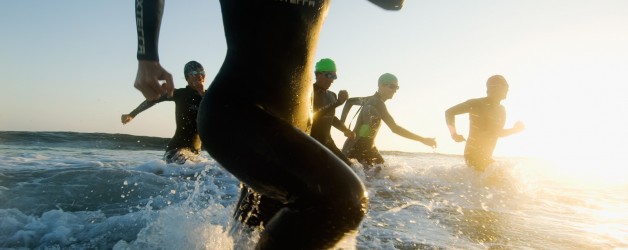Yoga for Triathletes
Competition season is in full swing for runners, cyclists, swimmers and of course, triathletes. Just passed the infamous Donner Lake Tri and Sprint, we’ve got the Ironman Lake Tahoe, numero tres, just around the corner on September 20th. I know I’ve got my fingers crossed, and so do thousands of others, for a fire-free, snowless weekend so this race can finally go off as it should…..Big and Beautiful just like the lake it represents!
Athletes can be seen all over our lovely Lake Tahoe basin, competing and training their butts off. I work with alot of these athletes, local and from afar and I understand how time consuming and tiring the training regimen can be. There is hardly time to spend with family and friends, let alone find anything to do but collapse from exhaustion at the end of the day. There is one thing however, that takes very little time and can be a huge benefit and supplement to a training program (besides massage therapy of course!). And that is yoga. While I think yoga can be an amazing addition to cross training, I think it may be better utilized as a supplemental addition to speed recovery time, promote relaxation, refine focus, and maintain flexibility and mobility.
It doesn’t have to occupy hours of your day. You can spend 10 or 15 minutes in the evening doing some key poses and attain the above effects. The following is a few poses that would most benefit triathletes, designed to release the tension and chronic overuse patterns I see with those who spend all their time doing their particular sport and no time “un-doing” the negative effects. Spend a few minutes in the evening allowing your hard-working mind and body the well-deserved rest and recovery it needs.
Good luck out there. Kick some booty!
1. Baddha Konasana, also known as Butterfly, bound angle and cobblers pose. Take a seat on the floor. Elevate your hips so they are 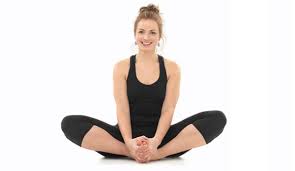 slightly above your knees and your pelvis can tip slightly forward (sit on blankets to do this). Take the soles of your feet together and let the knees drop open. Press your knees toward the floor while you hold onto the ankles with your hands, extending the spine long from tailbone to crown of the head. Breathe in and lengthen the spine, breathe out and drop the knees and sit bones toward the floor.
slightly above your knees and your pelvis can tip slightly forward (sit on blankets to do this). Take the soles of your feet together and let the knees drop open. Press your knees toward the floor while you hold onto the ankles with your hands, extending the spine long from tailbone to crown of the head. Breathe in and lengthen the spine, breathe out and drop the knees and sit bones toward the floor.
2. Dolphin. This is a modified Down Dog, good for opening the shoulders and for those who dont do well to weight bear on their wrists.  Start on all fours with your wrists beneath the shoulders and knees below the hips. Drop you forearms to the floor, keeping the fingers spread wide, pressing the hands into the floor all the way to fingertips. Slightly draw the elbows toward eachother as you externally rotate the shoulders, taking the armpits and shoulders away from the ears. Inhale and lift the knees off the floor, lifting the hips and sitbones up and back toward the ceiling while you begin to straighten the legs and drop the heels toward the floor.
Start on all fours with your wrists beneath the shoulders and knees below the hips. Drop you forearms to the floor, keeping the fingers spread wide, pressing the hands into the floor all the way to fingertips. Slightly draw the elbows toward eachother as you externally rotate the shoulders, taking the armpits and shoulders away from the ears. Inhale and lift the knees off the floor, lifting the hips and sitbones up and back toward the ceiling while you begin to straighten the legs and drop the heels toward the floor.
3. Anjaneyasana (or low lunge). From all fours, step the left foot forward between the hands. Come up onto fingertips with straight 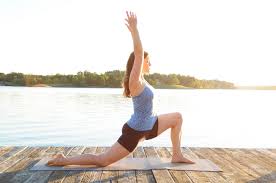 arms and lengthen the spine from tailbone to the crown of the head. Gently squeeze the inner thighs toward eachother until you feel the pelvic floor engage and from that engagement, bring the upper body upright, extending the arms overhead. Keep the engagement of the inner thighs as you extend the fingertips toward the ceiling and drop a little deeper into the lunge.
arms and lengthen the spine from tailbone to the crown of the head. Gently squeeze the inner thighs toward eachother until you feel the pelvic floor engage and from that engagement, bring the upper body upright, extending the arms overhead. Keep the engagement of the inner thighs as you extend the fingertips toward the ceiling and drop a little deeper into the lunge.
4. Malasana (or deep squat). From standing, take the feet slightly behind hip width with the toes turned out about 15 degrees or so. Bend 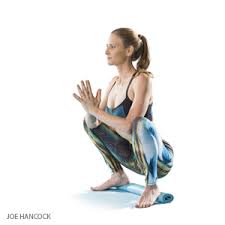 the knees deeply and dropyour butt and hips down until they are just above the floor and you are in a deep squat. Keep the feet flat on the floor from heel to toe (you can place a rolled up towel or blanket under the heels if you have a hard time keeping them in contact with the floor. Allow you weight to be evenly distributed between the front, back and sides of the feet. Bring the palms together between the legs and press your elbow into the inner knees. Lengthen the spine from tailbone to crown of the head as you inhale. Allow the tailbone and hips to drop deeper as you exhale.
the knees deeply and dropyour butt and hips down until they are just above the floor and you are in a deep squat. Keep the feet flat on the floor from heel to toe (you can place a rolled up towel or blanket under the heels if you have a hard time keeping them in contact with the floor. Allow you weight to be evenly distributed between the front, back and sides of the feet. Bring the palms together between the legs and press your elbow into the inner knees. Lengthen the spine from tailbone to crown of the head as you inhale. Allow the tailbone and hips to drop deeper as you exhale.
5. Ustrasana (or camel pose). Come onto your knees, toes tucked behind you, with the thighs and torso upright, hips over the knees, 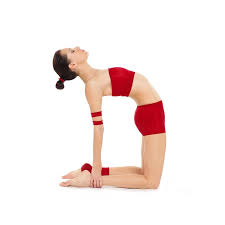 knees about hip width apart. Place your hands on your sacrum/low back with the fingers pointing downward (like you are putting your hands into your back pockets). Lengthen your spine from tailbone to the crown of your head as you lift your breastbone up and begin to lean the upper torso back, keeping gentle pressure into your hands. Take care to keep the hips over the knees and keep lifting the breastbone up as you extend back from your mid and upper spine. When you are about half way back, reach one hand at a time for your heels and rest the hands there, continuing to lift the sternum. Take the tailbone slightly down toward the floor, creating space in the lumber spine. Inhale and lengthen the spine, exhale as you lift the sternum.
knees about hip width apart. Place your hands on your sacrum/low back with the fingers pointing downward (like you are putting your hands into your back pockets). Lengthen your spine from tailbone to the crown of your head as you lift your breastbone up and begin to lean the upper torso back, keeping gentle pressure into your hands. Take care to keep the hips over the knees and keep lifting the breastbone up as you extend back from your mid and upper spine. When you are about half way back, reach one hand at a time for your heels and rest the hands there, continuing to lift the sternum. Take the tailbone slightly down toward the floor, creating space in the lumber spine. Inhale and lengthen the spine, exhale as you lift the sternum.
You can spend about 10 minutes with these poses and find some significant relief from the repetitive movements of running, cycling, swimming and other sports. I think you’ll find yoga can be a really simple addition to your training program without having to take up alot of your already limited and precious time. Give it a try and see for yourself!
With lots of light and love and plenty of good mojo,
Lauri Glenn & Bodhi Therapeutics.
If a yoga practice interests you, feel free to contact me about private instruction and public classes. I’d love to help you effectively integrate yoga into your life!

